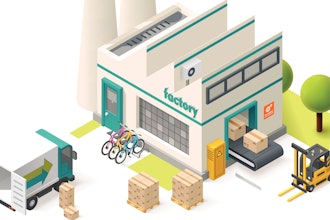
 With the recent concerns about Ebola and with winter flu season now approaching, this is an opportune time for facility managers and administrators of industrial locations to hear about a 40-year-old study that is as relevant today as it was when it was published back in 1971. The study involved the cleaning and maintenance of a hospital; however, what was revealed applies to all types of locations such as schools, airports, and industrial facilities.
With the recent concerns about Ebola and with winter flu season now approaching, this is an opportune time for facility managers and administrators of industrial locations to hear about a 40-year-old study that is as relevant today as it was when it was published back in 1971. The study involved the cleaning and maintenance of a hospital; however, what was revealed applies to all types of locations such as schools, airports, and industrial facilities.
The focus of the study was finding out how germs and bacteria that may cause disease are spread through cleaning. Of key concern were the mops commonly used to clean floors in all types of locations, including medical facilities. The researchers found that as these tools become soiled, they can spread germs and bacteria that can affect building users. Specifically, the study reported:
Following the demonstration of massive spread of bacterial contamination throughout the hospital by the wet-mopping techniques in use, quantitative studies were undertaken to determine the source of contamination and to institute measures of control. It was found that mops, stored wet, supported bacterial growth to very high levels and could not be adequately decontaminated by chemical disinfection. Laundering and adequate drying provided effective decontamination, but build-up of bacterial counts occurred if mops were not changed daily or if disinfectant was omitted from the wash-water.1
In other words, while there are ways to stop the spread of contamination when using the mop and bucket approach to cleaning floors, these steps are fairly extensive, and their effectiveness is not always guaranteed. Further, we must focus on the realities of cleaning, not only in healthcare locations but in other types of locations including warehouses and industrial facilities. Managers and administrators should ask themselves the following questions:
· How often do custodial workers launder and decontaminate mops and buckets during and after use?
· Are mops changed daily?
· Are they changed during the course of cleaning different areas of the facility?
· Are they disinfected daily?
· Are they stored wet?
The reality is mops (as well as buckets) are not cleaned as often as they should be or on a daily basis. Nor are they always changed daily or disinfected. However, they often are stored wet, which, according to the researchers, “supported bacterial growth to very high levels.”
This is but one example of how the very tools often used in cleaning—intended to stop the spread of disease—are in reality the cause of the spread of disease. And just so we are clear about how contaminants on floors can spread infection, studies have found that we have as many as 50 direct and indirect contacts with floors every day. Each time workers touch a shoelace that has touched the floor, it is as though they too have touched the floor. If germs and bacteria are on the floor, and now on the shoelace, they can be transferred to the worker as soon as he or she touches the eyes, nose, or mouth.
The Cleaning Cloth Caper
The cloths used to clean restroom fixtures, counters, desks, foodservice areas, “high-touch” areas such as light switches and doorknobs, and scores of other locations also have been found to spread potentially health-risking microorganisms from one area to another. Many in the professional cleaning industry have long believed this to be true, and in the past decade or so, this belief has been validated by different studies.
For instance, a study published in 2004, “Household Cleaning and Surface Disinfection: New Insights and Strategies,” investigated the use of cleaning cloths used repeatedly to clean different surfaces. The researchers here concluded that in situations where the cleaning procedure fails to thoroughly eliminate contamination from one surface and then uses the same cloth to wipe another surface, “the contamination is transferred to that [new] surface.”2
In other words, if a surface being cleaned is contaminated, that contamination can be transferred to the cleaning cloth. When this happens, and the cleaning cloth is then used on another surface, those microorganisms may find a new home on a different surface. Once again, the cleaning tool becomes the culprit, potentially spreading disease.
Because mops and cleaning cloths are likely the two most frequently used tools in professional cleaning and may be spreading germs and bacteria, plant administrators are likely wondering what options they have. Fortunately there are alternatives.
Healthier Cleaning
One simple way that administrators of industrial locations can keep their facilities healthier is to simply switch to color-coded cleaning systems where colors indicate which tools are used to clean which areas or surfaces in a facility.
A typical system is as follows:
- Red: For cleaning and disinfecting toilets, urinals, and high-risk or hazardous restroom areas
- Yellow: For cleaning showers, mirrors, and other low-risk restroom areas
- Green: For cleaning areas where food is handled and stored
- Blue: For all other areas and surface types, but never in areas where red, yellow, or green tools are mandated (In the United States, blue is often used to clean glass areas.)
This color-coding system can be applied to cleaning cloths as well as microfiber flat mops, with red mops used for cleaning restrooms, green for foodservice areas, etc. Some systems even take things a step further to help protect health. Along with being color coded, at least one brand of microfiber cloths can be folded into quadrants, allowing the cleaning worker to use a fresh section of the cloth for each surface area cleaned.
However, because many industrial locations are large with large restrooms, a more effective way to clean these areas is not with cleaning clothes but with spray-and-vac systems. The term “spray-and-vac” was coined by ISSA, the worldwide cleaning association, and refers to equipment that injects chemicals onto surfaces and fixtures to be cleaned, which are then high-pressure rinsed. This is followed by vacuuming up the solution and contaminants, totally removing them from the areas cleaned.
In schools where such systems are commonly used, surfaces are often tested using ATP monitoring system. High levels of adenosine triphosphate (ATP) is viewed as a red flag that germs and bacteria are present on a surface. However, according to Rex Morrison, CEO and president of Process Cleaning for Healthy Schools, a restroom may start with an ATP reading of 1,700 – a very high ATP reading – before cleaning but register as low as 4 or 5 after cleaning with a spray-and-vac cleaning system.
Industrial administrators are dealing with some real-world healthcare issues that cannot be overlooked. At one time, the biggest concern building users had when it came to communicable diseases was catching a cold or possibly the flu from a co-worker. Things can be much more serious today, and the last thing we want is for the tools we use to clean facilities—and keep them healthy—to instead spread contamination. Administrators are advised to rethink their cleaning strategies. The programs that seemed to have worked successfully even a few years ago may not be healthy today.
Robert Kravitz is a frequent writer for the professional cleaning and healthcare industries. He may be reached at [email protected]
1Westwood, J. C., Mitchell, M. A., Legacé, S. “Hospital Sanitation: The Massive Bacterial Contamination of the Wet Mop,” Applied Microbiology, 21, no. 4 (1971): 693-7.
2 Exner, M., Vacata, V., Hornei, B., Dietlein, E., Gebel, J. “Household Cleaning and Surface Disinfection: New Insights and Strategies,” Journal of Hospital Infection, 56, Supp. 2 (2004): 70-75.























